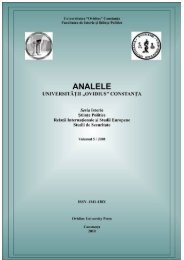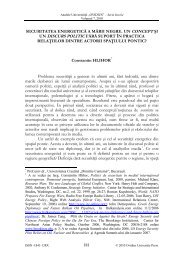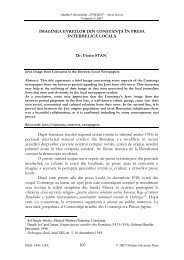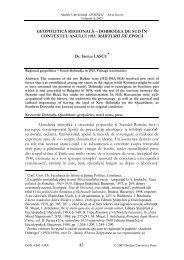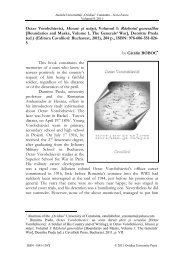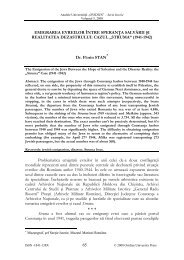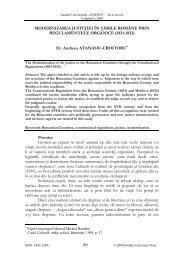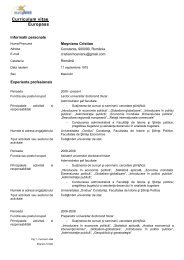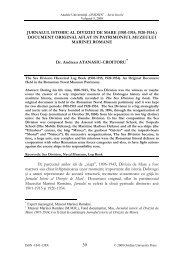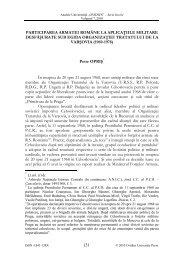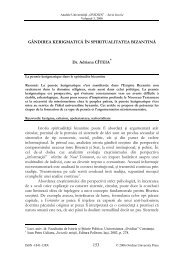analele universitÄÅ£ii âovidiusâ constanÅ£a - AUOCSI
analele universitÄÅ£ii âovidiusâ constanÅ£a - AUOCSI
analele universitÄÅ£ii âovidiusâ constanÅ£a - AUOCSI
Create successful ePaper yourself
Turn your PDF publications into a flip-book with our unique Google optimized e-Paper software.
Costel Coroban / Analele Universităţii „OVIDIUS” / Vol. 6/ 2009<br />
lecture only with two loaded pistols by his side 47 (sic!). Scotland did not suffer so<br />
much distress since the days of William Wallace and Robert the Bruce. 48<br />
In an apparent similarity with the events that would take place four<br />
years later at Westminster, the King was confronted by the General Assembly of<br />
the Kirk at Glasgow. Even though outlawed, the Assembly abolished the<br />
Scottish Bishoprics and restored the Presbyterian order in the Kirk through a<br />
Covenant, which the people signed in an outcry against the policies of Charles I. 49<br />
Their main leader was the Puritan Earl of Argyll, Chief of the<br />
Campbell’s, the most widespread and influent clan of the Highlands. 50 He<br />
benefited the military experience of the Scots Diaspora, which had formed the<br />
bravest Protestant regiments on the continent under Gustav Adolphus and<br />
other renowned commanders. The Scots that returned home from Europe<br />
assembled under the military leadership of Alexander Leslie. Thus, in his<br />
ancestral Scotland, Charles I was opposed by a considerable force, which he<br />
could not check without the endowment of Westminster.<br />
This conflict is remembered in historiography as the Bishops’ Wars,<br />
with two phases: one in 1639 and the second in 1640. In 1639 James Graham<br />
Marquis of Montrose defeats the English 51 and truce is made by the Treaty of<br />
Berwick, where Charles I temporarily yields to the Kirk’s demands. The second<br />
phase of the Bishops’ Wars begins in 1640 with Earl Strafford’s (the King’s<br />
favorite statesman) efforts for creating a new army. To this, Montrose responds<br />
by marching his Scots Cavalry to Northumberland and Durham, which he<br />
decides to keep as a guarantee until the King’s acceptance of the Covenant and<br />
his paying of the sum decided by the Treaty of Ripon (1640).<br />
To this threat, Charles I responds by calling the Long Parliament, 52 thus<br />
opening the way for the English Civil Wars, which further weakened his position<br />
that he finally had to accept the Presbyterian confession of the Kirk and<br />
furthermore, award more liberty to the Parliament of Edinburgh (including the<br />
cause of government responsibility before it). 53<br />
Epilogue<br />
In a way, one could argue that the outburst of Jenny Geddes, a Scots<br />
woman “of the Bible” (as Nicolae Iorga would say) ultimately lead to the<br />
execution of Charles I on 30 th January 1649. Of course, this assertion must be<br />
47 Rosalind Mitchinson, op. cit., p. 147.<br />
48 G. M. Trevelyan, op. cit., p. 459.<br />
49 Ibidem.<br />
50 Ibidem.<br />
51 Angela Anderson, Războaiele civile 1640-1649 [The Civil Wars 1640-1649], Editura All<br />
Educational, Bucureşti, 2002, p. 7.<br />
52 G.M. Trevelyan, op. cit., p. 460.<br />
53 Peter & Fiona Sommerset Fry, op. cit., pp. 172-173.<br />
ISSN -1841-138X 214 © 2009 Ovidius University Press



